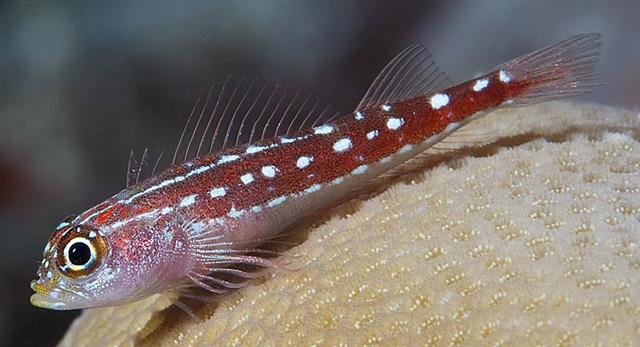| Tripterygiidae (Triplefin blennies), subfamily: Tripterygiinae |
| 2.76 cm SL (male/unsexed) |
|
demersal; marine; depth range 0 - 10 m |
| Western Indian Ocean: presently endemic to the Maldives. |
|
Dorsal spines (total): 15-17; Dorsal soft rays (total): 9-11; Anal spines: 1-1; Anal soft rays: 17-21; Vertebrae: 35-36. Diagnosis: Dorsal fin III + XIII+ 10, 2nd fin twice height of 1st; anal fin I + 16-18; pectoral rays 15 (3+6+6); pelvic fin I, 2, spine short and hidden, segmented rays simple, partially united by membrane. Vertebrae 10 + 25-26. LL total lateral scales 36-38; tubed 13-21 (16-17) scales, ends below 3rd dorsal fin; nape, belly, 1st dorsal fin and anterior anal-fin base scaleless, caudal-fin base with 2 rows of scales. Mandibular pores 3+2-1+3. Labial folds and orbital cirrus absent. Head length 3.4 in SL; eye 2.4, maxilla 2.3 in HL. Males overall reddish with bluish dots and streaks on head, forming stripes anteriorly on body, ventrally light grey, fins pigmented; females paler, without spots and stripes, ventrally white, fins transluscent (Ref. 75031). |
| Eggs are hemispherical and covered with numerous sticky threads that anchor them in the algae on the nesting sites (Ref. 240). Larvae are planktonic which occur primarily in shallow, nearshore waters (Ref. 94114). |
|
Data deficient (DD); Date assessed: 07 May 2010 Ref. (130435)
|
| harmless |
Source and more info: www.fishbase.org. For personal, classroom, and other internal use only. Not for publication.

